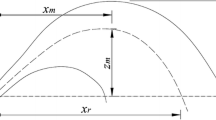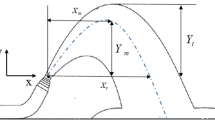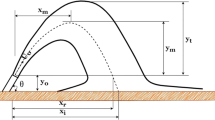Abstract
Inclined dense jets are commonly used to mitigate the environmental impacts of brine discharge in coastal desalination plants. Numerous studies have been performed to numerically simulate the sophisticated structures of the flow within this process. However, numerical prediction of the process is still a challenge. The present paper performs a comprehensive numerical study using the large eddy simulation (LES) approach on inclined dense jets oriented at angles 15°, 30°, 45°, 60°, and 75°, with a particular emphasis on the near-wall region, where the most complicated structures of the flow occur. The objective is to evaluate the capability of the LES approach to replicate the mixing processes of the brine jets. Besides numerical simulations, a series of experiments using the planar laser-induced fluorescence technique is carried out to compare each numerical simulation with its experimental correspondence. Both numerical and experimental results are presented in comparative figures compared to previous experimental data. The comparisons indicated that the LES model could reasonably predict the geometrical and mixing characteristics of inclined dense jets; however, the flow features are still underestimated by up to 25%. Moreover, the model could reproduce the local concentration build-up near the impact point. The processes within the near-wall region leading to this local decrease of dilution are discussed in detail. Additionally, a novel criterion is proposed to predict when the flow reaches a quasi-steady-state. The criterion can be used to manage the computational expenses, especially in simulations with high demanding computing power such as LES.
Article Highlights
-
The capability of the LES approach to reproduce the mixing behavior of inclined dense jets was investigated.
-
The flow behavior in the near-wall region was analyzed in detail.
-
The LES approach was able to predict the flow behavior, especially in the near-wall region, with reasonable accuracy.










Similar content being viewed by others
Notes
United States Bureau of Reclamation.
References
Abessi O (2018) Brine disposal and management—planning, design, and implementation. In: sustainable desalination handbook: plant selection, design and implementation
Saeedi M, Farahani AA, Abessi O, Bleninger T (2012) Laboratory studies defining flow regimes for negatively buoyant surface discharges into crossflow. Environ Fluid Mech 12:439–449. https://doi.org/10.1007/S10652-012-9245-4
Ghayoor S, Hamidi M, Abessi O (2019) Experimental analysis of turbulent flows in brine discharge of coastal desalination plants. J Oceanogr 10:101–111. https://doi.org/10.29252/joc.10.39.101 (In Persian)
Roberts PJW, Ferrier A, Daviero G (1997) Mixing in inclined dense jets. J Hydraul Eng 123:693–699. https://doi.org/10.1061/(ASCE)0733-9429(1997)123:8(693)
Abessi O, Roberts PJW (2017) Multiport diffusers for dense discharge in flowing ambient water. J Hydraul Eng 143:04017003. https://doi.org/10.1061/(ASCE)HY.1943-7900.0001279
Kikkert GA, Davidson MJ, Nokes RI (2007) Inclined negatively buoyant discharges. J Hydraul Eng 133:545–554. https://doi.org/10.1061/(ASCE)0733-9429(2007)133:5(545)
Jirka GH (2008) Improved discharge configurations for brine effluents from desalination plants. J Hydraul Eng 134:116–120. https://doi.org/10.1061/(ASCE)0733-9429(2008)134:1(116)
Lai CCK, Lee JHW (2012) Mixing of inclined dense jets in stationary ambient. J Hydro Environ Res 6:9–28. https://doi.org/10.1016/j.jher.2011.08.003
Oliver CJ, Davidson MJ, Nokes RI (2013) Behavior of dense discharges beyond the return point. J Hydraul Eng 139:1304–1308. https://doi.org/10.1061/(ASCE)HY.1943-7900.0000781
Cederwall K (1968) Hydraulics of marine waste water disposal. Chalmers tekniska högskola
Zeitoun MA, Reid RO, McHilhenny WF, Mitchell TM (1970) Model studies of ocean outfall systems for desalination plants. Off Saline Water US Department of the Interior, Washington
Papakonstantis IG, Christodoulou GC, Papanicolaou PN (2011) Inclined negatively buoyant jets 1: geometrical characteristics. J Hydraul Res. https://doi.org/10.1080/00221686.2010.537153
Papakonstantis IG, Christodoulou GC, Papanicolaou PN (2011) Inclined negatively buoyant jets 2: concentration measurements. J Hydraul Res. https://doi.org/10.1080/00221686.2010.542617
Roberts PJW, Abessi O (2014) Optimization of desalination diffusers using three-dimensional laser-induced fluorescence. Rep Prep US Bur Reclam Agreem
Antenucci JP, Ransome T, Ferguson M (2015) Field validation of a multiport brine diffuser in a coastal environment: implications for design. In: Australian Coasts and Ports 2015 Conference
Baum MJ, Albert S, Grinham A, Gibbes B (2019) Spatiotemporal influences of open-coastal forcing dynamics on a dense multiport diffuser outfall. J Hydraul Eng 145:05019004. https://doi.org/10.1061/(ASCE)HY.1943-7900.0001622
Baum MJ, Gibbes B, Grinham A et al (2018) Near-field observations of an offshore multiport brine diffuser under various operating conditions. J Hydraul Eng 144:05018007. https://doi.org/10.1061/(ASCE)HY.1943-7900.0001524
Abessi O, Roberts PJW (2014) Multiport diffusers for dense discharges. J Hydraul Eng 140:04014032. https://doi.org/10.1061/(ASCE)HY.1943-7900.0000882
Papakonstantis IG, Tsatsara EI (2018) Trajectory characteristics of inclined turbulent dense jets. Environ Process 5:539–554. https://doi.org/10.1007/s40710-018-0307-6
Papakonstantis IG, Tsatsara EI (2019) Mixing characteristics of inclined turbulent dense jets. Environ Process. https://doi.org/10.1007/s40710-019-00359-w
Crowe AT, Davidson MJ, Nokes RI (2016) Velocity measurements in inclined negatively buoyant jets. Environ Fluid Mech 16:503–520. https://doi.org/10.1007/s10652-015-9435-y
Ramakanth A, Davidson MJ, Nokes RI (2022) Laboratory study to quantify lower boundary influences on desalination discharges. Desalination 529:115641. https://doi.org/10.1016/J.DESAL.2022.115641
Vafeiadou P, Papakonstantis I, Christodoulou G (2005) Numerical simulation of inclined negatively buoyant jets. In: The 9th international conference on environmental science and technology, September. pp 1–3
Oliver CJ, Davidson MJ, Nokes RI (2008) k-ε Predictions of the initial mixing of desalination discharges. Environ Fluid Mech 8:617–625. https://doi.org/10.1007/s10652-008-9108-1
Jirka GH (2004) Integral model for turbulent buoyant jets in unbounded stratified flows. Part I: single round jet. Environ Fluid Mech 4:1–56. https://doi.org/10.1023/A:1025583110842
Lee JHW, Cheung V, Wang WP, Cheung SKB (2000) Lagrangian modeling and visualization of rosette outfall plumes. In: Proc Hydroinformatics Iowa
Kheirkhah Gildeh H, Mohammadian A, Nistor I, Qiblawey H (2015) Numerical modeling of 30° and 45° inclined dense turbulent jets in stationary ambient. Environ Fluid Mech 15:537–562. https://doi.org/10.1007/s10652-014-9372-1
Zhang S, Law AW-K, Jiang M (2017) Large eddy simulations of 45° and 60° inclined dense jets with bottom impact. J Hydro Environ Res 15:54–66. https://doi.org/10.1016/j.jher.2017.02.001
Abessi O, Roberts PJW (2015) Effect of nozzle orientation on dense jets in stagnant environments. J Hydraul Eng 141:06015009. https://doi.org/10.1061/(ASCE)HY.1943-7900.0001032
Tahmooresi S, Ahmadyar D (2021) Effects of turbulent Schmidt number on CFD simulation of 45° inclined negatively buoyant jets. Environ Fluid Mech 21:39–62. https://doi.org/10.1007/s10652-020-09762-6
Ramezani M, Abessi O, Firoozjaee AR (2021) Effect of proximity to bed on 30° and 45° inclined dense jets: a numerical study. Environ Process 8:1141–1164. https://doi.org/10.1007/s40710-021-00533-z
Pope SB (2000) Turbulent flows. Cambridge University Press
Liu X, Zhang J (2019) Computational fluid dynamics: applications in water, wastewater, and stormwater treatment. American Society of Civil Engineers, Reston
Zhang S, Jiang B, Law AW-K, Zhao B (2016) Large eddy simulations of 45° inclined dense jets. Environ Fluid Mech 16:101–121. https://doi.org/10.1007/s10652-015-9415-2
Tofighian H, Amani E, Saffar-Avval M (2020) A large eddy simulation study of cyclones: the effect of sub-models on efficiency and erosion prediction. Powder Technol 360:1237–1252. https://doi.org/10.1016/j.powtec.2019.10.091
Kim W-W, Menon S (1995) A new dynamic one-equation subgrid-scale model for large eddy simulations. In: 33rd Aerospace Sciences Meeting and Exhibit. American Institute of Aeronautics and Astronautics, Reston, Virigina
Holzmann T (2018) Mathematics, numerics, derivations and OpenFOAM®. Holzmann CFD
Jasak H (1996) Error analysis and estimation for the finite volume method with applications to fluid flows. Imperial College London University of London
Martínez J, Piscaglia F, Montorfano A, Onorati A, Aithal SM (2015) Influence of spatial discretization schemes on accuracy of explicit LES: canonical problems to engine-like geometries. Comput Fluids 117:62–78. https://doi.org/10.1016/j.compfluid.2015.05.007
Epikhin AS (2019) Numerical schemes and hybrid approach for the simulation of unsteady turbulent flows. Math Model Comput Simul 11:1019–1031. https://doi.org/10.1134/S2070048219060024
Moukalled F, Mangani L, Darwish M (2016) The finite volume method in computational fluid dynamics. Springer International Publishing
Celik IB, Cehreli ZN, Yavuz I (2005) Index of resolution quality for large eddy simulations. J Fluids Eng 127:949–958. https://doi.org/10.1115/1.1990201
Pope SB (2004) Ten questions concerning the large-eddy simulation of turbulent flows. New J Phys 6:1–35. https://doi.org/10.1088/1367-2630/6/1/035
Greenshields CJ (2015) OpenFoam user guide. OpenFOAM Foundation Ltd
Tian X, Roberts PJW (2003) A 3D LIF system for turbulent buoyant jet flows. Exp Fluids 35:636–647. https://doi.org/10.1007/s00348-003-0714-x
Abessi O, Ramani Firoozjayee A, Hamidi M, Bassam M, Khodabakhshi Z (2020) Three dimensional laser scanning system for illumination of fluorescent flow for the environmental hydraulics investigations. J Hydraul 14:69–81. https://doi.org/10.30482/JHYD.2020.105499 (in Persian)
Daviero GJ, Roberts PJW, Maile K (2001) Refractive index matching in large-scale stratified experiments. Exp Fluids 31:119–126. https://doi.org/10.1007/s003480000260
Gungor E, Roberts PJW (2009) Experimental studies on vertical dense jets in a flowing current. J Hydraul Eng 135:935–948. https://doi.org/10.1061/(ASCE)HY.1943-7900.0000106
Fedele F, Abessi O, Roberts PJ (2015) Symmetry reduction of turbulent pipe flows. J Fluid Mech 779:390–410. https://doi.org/10.1017/jfm.2015.423
Fischer HB, List JE, Koh CR, Imberger J, Brooks N (1979) Mixing in inland and coastal waters. Elsevier
Roberts PJW, Toms G (1987) Inclined dense jets in flowing current. J Hydraul Eng 113:323–340. https://doi.org/10.1061/(ASCE)0733-9429(1987)113:3(323)
Abessi O, Roberts PJW (2016) Dense jet discharges in shallow water. J Hydraul Eng 142:04015033. https://doi.org/10.1061/(ASCE)HY.1943-7900.0001057
Jiang B, Law AW-K, Lee JH-W (2014) Mixing of 30° and 45° inclined dense jets in shallow coastal waters. J Hydraul Eng 140:241–253. https://doi.org/10.1061/(ASCE)HY.1943-7900.0000819
Shao D, Law AWK (2010) Mixing and boundary interactions of 30° and 45° inclined dense jets. Environ Fluid Mech 10:521–553. https://doi.org/10.1007/s10652-010-9171-2
Ramezani M, Abessi O, Rahmani Firoozjayee A (2021) Experimental study of geometrical characteristics of free and boundary-affected 30° inclined dense jets in unstratified stagnant environments. J Water Wastewater 32:91–102. https://doi.org/10.22093/WWJ.2020.238900.3047 (in Persian)
Aghajanpour A (2018) Experimental and numerical modeling of upwardly inclined turbulent dense jet unjection into a stagnant ambient. Babol Noshirvani University of Technology
Crowe AT (2013) Inclined negatively buoyant jets and boundary interaction. University of Canterbury
Kikkert GA (2006) Buoyant jets with two and three-dimensional trajectories. University of Canterbury
Cipollina A, Brucato A, Grisafi F, Nicosia S (2005) Bench-scale investigation of inclined dense jets. J Hydraul Eng 131:1017–1022. https://doi.org/10.1061/(ASCE)0733-9429(2005)131:11(1017)
Oliver CJ, Davidson MJ, Nokes RI (2013) Removing the boundary influence on negatively buoyant jets. Environ Fluid Mech. https://doi.org/10.1007/s10652-013-9278-3
Reungoat D, Rivière N, Fauré JP (2007) 3C PIV and PLIF measurement in turbulent mixing. J Vis 10:99–110. https://doi.org/10.1007/BF03181809
Ramezani M, Abessi O, Rahmani Firoozjayee A (2020) Numerical simulation of dense discharges from 30° submerged inclined jet in free and bed-affected conditions. J Hydraul 15:75–91. https://doi.org/10.30482/JHYD.2020.228141.1454 (in Persian)
Baum MJ, Gibbes B (2020) Field-scale numerical modeling of a dense multiport diffuser outfall in crossflow. J Hydraul Eng 146:05019006. https://doi.org/10.1061/(ASCE)HY.1943-7900.0001635
Papanicolaou PN, Papakonstantis IG, Christodoulou GC (2008) On the entrainment coefficient in negatively buoyant jets. J Fluid Mech 614:447–470. https://doi.org/10.1017/S0022112008003509
Papakonstantis IG, Papanicolaou PN (2022) On the computational modeling of inclined brine discharges. Fluids 7:86. https://doi.org/10.3390/FLUIDS7020086
Bloutsos AA, Yannopoulos PC (2020) Revisiting mean flow and mixing properties of negatively round buoyant jets using the esca** mass approach (EMA). Fluids 5:131. https://doi.org/10.3390/FLUIDS5030131
Oliver CJ, Davidson MJ, Nokes RI (2013) Predicting the near-field mixing of desalination discharges in a stationary environment. Desalination 309:148–155. https://doi.org/10.1016/J.DESAL.2012.09.031
Crowe AT, Davidson MJ, Nokes RI (2016) Modified reduced buoyancy flux model for desalination discharges. Desalination 378:53–59. https://doi.org/10.1016/J.DESAL.2015.08.010
Yannopoulos PC, Bloutsos AA (2012) Esca** mass approach for inclined plane and round buoyant jets. J Fluid Mech 695:81–111. https://doi.org/10.1017/JFM.2011.564
Acknowledgements
The authors acknowledge the funding support of the Babol Noshirvani University of Technology through grant program No. BNUT/390035/1400.
Author information
Authors and Affiliations
Corresponding author
Ethics declarations
Conflict of interest
The authors declare that they have no known competing financial interests or personal relationships that could have appeared to influence the work reported in this paper.
Additional information
Publisher's Note
Springer Nature remains neutral with regard to jurisdictional claims in published maps and institutional affiliations.
Rights and permissions
About this article
Cite this article
Tofighian, H., Aghajanpour, A., Abessi, O. et al. Simulation of inclined dense jets in stagnant environments: an LES and experimental study. Environ Fluid Mech 22, 1161–1185 (2022). https://doi.org/10.1007/s10652-022-09884-z
Received:
Accepted:
Published:
Issue Date:
DOI: https://doi.org/10.1007/s10652-022-09884-z




